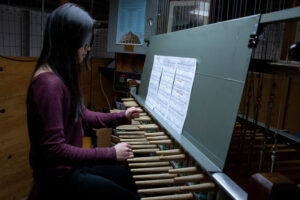If you’ve ever visited the University of Rochester’s River Campus, you’ve likely heard the melodious sounds of the carillon ringing. Many of these songs are performed by a small group of undergraduate students who have been accepted into the competitive carillon class held by the Music Department.
Senior Sarah Lee, a data science and business double major with a minor in music, auditioned for the class in October 2023 and has spent the Spring 2023 semester learning how to play the carillon and performing at the weekly carillon concerts hosted on Sundays.
How’d she get here?
The carillon classes exist in the first place due to an Eastman student who was already proficient in the carillon. She started teaching other students in the late 2000s and when she graduated in 2008 she asked the current program director Doris Aman to take over. The Music Department held a pilot program to test the class and it has been running ever since.
Lee has over a decade of piano experience, playing from when she was in kindergarten through high school. Her other classes for her music minor were all theory based, so when she saw MUSC 104 while searching for classes to finish out her senior year, she knew she wanted to try it. The professor, Doris Aman, hosted auditions for the spring semester in late October where Lee and others got a crash course in carillon history and how to play it before being let loose on the instrument to sight read excerpts of songs. There weren’t that many spots open, as there were students who wanted to retake the class who got priority, in addition to those who were registered for MUSC 204 which doubles the amount of time you get to spend playing the carillon, but Lee made it through auditions, excited to start learning when she came back in January.
What’s the class structure like?
Every student in MUSC 104 gets a half hour lesson every week in the tower in addition to coming up to practice during “open tower” with the professor or TA. Outside of the genuine carillon, students are expected to practice daily on one of the two practice carillons. There’s one located in Spurrier Hall, with another, more expensive one, located in Dewey Hall that is only accessible to those who have already taken MUSC 104. There are also weekly carillon concerts held throughout the semester, with students required to perform a song for at least three of them.
“We get a lot of freedom to choose the music we want to do,” Lee noted, adding, “I always looked forward to practicing every week.” Her favorite song she’s learned this semester has been La Canción Del Emperador by Luis De Narváez which she got to perform in April. It was a technically challenging song to play on the carillon but she loved how expressive it was.
What’s it like playing the carillon?
The carillon is not your average keyboard-style instrument. The keys, called batons, sit together at hand level, along with pedals at the feet. Each baton and pedal is connected to a wire that pulls a clapper to hit the inner wall of its associated bell. The carillon has to be set up properly before playing to avoid damage and ensure the clapper stays two inches away from the side of the bell. Each bell has to be “prepped” before it is rung, meaning “If you want to play on the beat you have to be at the key before you need to play the note,” Lee explained. She demonstrated this, bringing the baton almost all the way down to the bottom of its slot, leaving a slight gap between it and the velvet. Then, with her hand in a loosely formed fist, she quickly flicked her wrist, pressing the baton all the way down and letting out a nice ring from the bell for the campus to hear.

“It’s such a unique opportunity,” Lee shared, “What are the chances I come to a school that offers carillon lessons like this?”
In New York state there are only four carillons in upstate New York and three in New York City, with the University of Rochester having the only carillon teaching program in the state. Some schools do have their own bells, but they are technically chimes, as they have 8-22 bells. The University’s Hopeman Memorial Carillon is made up of 50 bells, installed in 1973. It’s a rare sight to actually see the bells, as they are hidden away above the small room where the players sit, with the professor herself only seeing them once during their 2017 refurbishment.
Want to learn more about the carillon? The Hopeman Memorial Carillon’s page can answer most of your questions!

